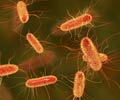According to researchers, they have identified a key mechanism disease-fighting cells which are used to swallow a common microbe that can impose havoc with the digestive system and which has been implicated in many outbreaks of food poisoning.An analysis of the defense tactics of the immune system of the fruitfly Drosophila led investigators to pinpoint a molecule that engineers search-and-destroy missions by white blood cells called macrophages against the Escherichia coli bacteria.
Most E. coli strains are harmless, but the variety toxic to humans can inflame intestinal walls, leading to serious illness and even death. In 1000, health officials in 20 states reported 1,800 confirmed cases of infection by the foodborne pathogen, 150 of which required hospitalization and four of which proved fatal, according to the Centers for Disease Control and Prevention in Atlanta.While the majority of E.coli outbreaks have involved ground beef, the bacteria also have tainted unpasteurized apple and orange juice, unpasteurized milk, alfalfa sprouts and water. As members of the body's extensive and highly coordinated warrior forces that fight such infectious agents, macrophages destroy the enemy by ingesting it in a process called phagocytosis. The researchers detailed these defensive maneuvers in fruitflies in an advance online publication of the British journal Nature.
"The basic templates of how organisms protect themselves against infection go back millions of years in evolution, so we can learn lessons from flies that apply to humans," said senior study author R. Alan Ezekowitz, Charles Wilder Professor of Pediatrics at Harvard Medical School, head of the Laboratory of Developmental Immunology and chief of pediatrics at MassGeneral Hospital for Children in Boston.
"In this study we look at a very ancient but very important process: how bacteria are recognized and eaten by immune cells called phagocytes," a contingent that includes macrophages, said Ezekowitz, who has devoted the past eight years to the research.
Using a cutting-edge technique that allowed them to turn off specific genes, Ezekowitz and his team identified 36 macrophage proteins essential to the phagocytosis process. One, called PGRP-LC, is a cell surface receptor that sits on the outer membrane and receives chemical signals. When the scientists deactivated PGRP-LC, the macrophages lost their ability to detect and devour the E. coli microbes -- but not another type of bacteria called Staphylococcus aureus, which also can cause food poisoning.
This pointed to the protein's essential role in enabling the macrophages to react specifically to so-called gram-negative bacteria since S. aureus is of the gram-positive variety. To test this view, team member Pascal Mantruelli genetically engineered a group of Drosophila with a mutated version of PGRP-LC. Indeed, these flies were much more susceptible to E. coli infection than were their normal counterparts, the researchers observed.
Advertisement
"I think the importance of this paper is they've been able to solve how the fruitfly responds to the E. coli bacteria and to show the role of a specific molecule," Charles Hackett, chief of the Molecular and Structural Immunology Section at the National Institute of Allergy and Infectious Disease in Bethesda, Md., said in a telephone interview. "The importance for immunology in general is that humans have a molecule similar to the one they found in the fly. This will no doubt help us understand the function of the human molecule."
Advertisement
Beyond the potential furthering of understanding of the human response to E. coli, the research provides important insight into insect immunity, Hackett said."Insects related to fruitflies, like mosquitoes, can spread disease, and I think it's important to know how insects can become infected and how they defend against the infection to understand disease transmission by insects."
"For many infectious diseases like E. coli sepsis, tuberculosis and anthrax, the bacteria are taken up by white blood cells called macrophages. The disease states are related to the fact the microbes manipulate the cell once inside, and this causes the cells to release toxic molecules that try to kill the bacteria but can kill the person as well," Ezekowitz told UPI. "This work provides a method for using a simplified system in flies to work out how bacteria interact with the cell and then to devise ways to intervene on behalf of the cell and the infected host."











